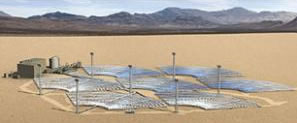
Britain’s armed forces are planning to end the military dependency on fossil fuels. Possible innovations include unmanned attack aircraft powered by the sun. They would fire missiles fuelled with hydrogen produced by feeding algae to microbes. Tanks could be electrically powered or run on fuel produced from oil squeezed out of weeds so hardy they can grow in the desert. Ships could run completely on electricity produced from generators powered by synthetic fuels made from grass. The environmental requirements of the army, navy and air force will be presented this week to specially vetted defence and research companies. The Ministry of Defence (MoD) said last week that many of the ideas would come to fruition only in the next generation. The US Air Force, however, is expected to start converting its aircraft to use a mix of synthetic and petroleum-based fuel by the end of 2010 and the RAF is likely to follow suit. The Royal Navy’s new Type45 destroyers already use all-electric propulsion, albeit produced by gas generators, and greener ways of producing the electricity are being explored in conjunction with the French. Turning all three services “green” was one of a number of new defence targets outlined last week by Paul Stein, the MoD’s science and technology director, to the Royal Aeronautical Society in London. Others included more unmanned, missile-carrying aircraft; lightweight tanks; ultra-light equipment for soldiers and futuristic communications devices. While some of the plan will be made public, most will be made available on a secure website to selected company and university research departments. “It will provide clear direction to the research and development community,” the ministry said.
Continue reading 
 Soon setting up a solar power station is to get a lot more user friendly and a new technology could change the solar industry. IKEA changed the rules for furnishing a home. The eSolar power plant is based on mass manufactured components, and designed for rapid construction, uniform modularity, and unlimited scalability. Each eSolar module, though, is designed to generate 33MW of power — enough juice to power 10,000 homes. If you need 330MW, you just buy ten modules and put them together. It’s not exactly flat-pack home furnishings, but it’s the same world-changing idea. Presumably, you’ll need more tools than those little Allen wrenches and nifty fasteners IKEA supplies with its furniture. However, you don’t need the heavy equipment, cranes and trained engineers now required to put traditional thermal power plants together: eSolar has replaced expensive steel, concrete, and brute force with inexpensive computing power and elegant algorithms. This new method of installing a solar power plant minimizes costly civil construction and the use of heavy equipment, dramatically reducing project cost and deployment time. That’s a big claim when you consider that a 33MW modular plant needs 160 acres of land — about 1/4 of a square mile. It’s still a job for a trained construction crew that knows what to do when they open the eSolar box. Inside are many identical towers and thousands of small mirrors — each about a meter square in size — engineered back in eSolar’s manufacturing plant — to essentially snap together. At least that’s how it seems after talking to eSolar executives, who are playing the details very close to the chest. They’re promising to show off a portion of a module at a demonstration facility somewhere in Southern California before the end of this year. eSolar says solar energy that is cheaper than coal is the goal. The company isn’t yet ready to divulge the cost of a module, but claims that right now, its solution is competitive with natural gas, which can produce electricity for 9 cents a kilowatt-hour. Between the rising price of both gas and construction,
Soon setting up a solar power station is to get a lot more user friendly and a new technology could change the solar industry. IKEA changed the rules for furnishing a home. The eSolar power plant is based on mass manufactured components, and designed for rapid construction, uniform modularity, and unlimited scalability. Each eSolar module, though, is designed to generate 33MW of power — enough juice to power 10,000 homes. If you need 330MW, you just buy ten modules and put them together. It’s not exactly flat-pack home furnishings, but it’s the same world-changing idea. Presumably, you’ll need more tools than those little Allen wrenches and nifty fasteners IKEA supplies with its furniture. However, you don’t need the heavy equipment, cranes and trained engineers now required to put traditional thermal power plants together: eSolar has replaced expensive steel, concrete, and brute force with inexpensive computing power and elegant algorithms. This new method of installing a solar power plant minimizes costly civil construction and the use of heavy equipment, dramatically reducing project cost and deployment time. That’s a big claim when you consider that a 33MW modular plant needs 160 acres of land — about 1/4 of a square mile. It’s still a job for a trained construction crew that knows what to do when they open the eSolar box. Inside are many identical towers and thousands of small mirrors — each about a meter square in size — engineered back in eSolar’s manufacturing plant — to essentially snap together. At least that’s how it seems after talking to eSolar executives, who are playing the details very close to the chest. They’re promising to show off a portion of a module at a demonstration facility somewhere in Southern California before the end of this year. eSolar says solar energy that is cheaper than coal is the goal. The company isn’t yet ready to divulge the cost of a module, but claims that right now, its solution is competitive with natural gas, which can produce electricity for 9 cents a kilowatt-hour. Between the rising price of both gas and construction,
Continue reading 


